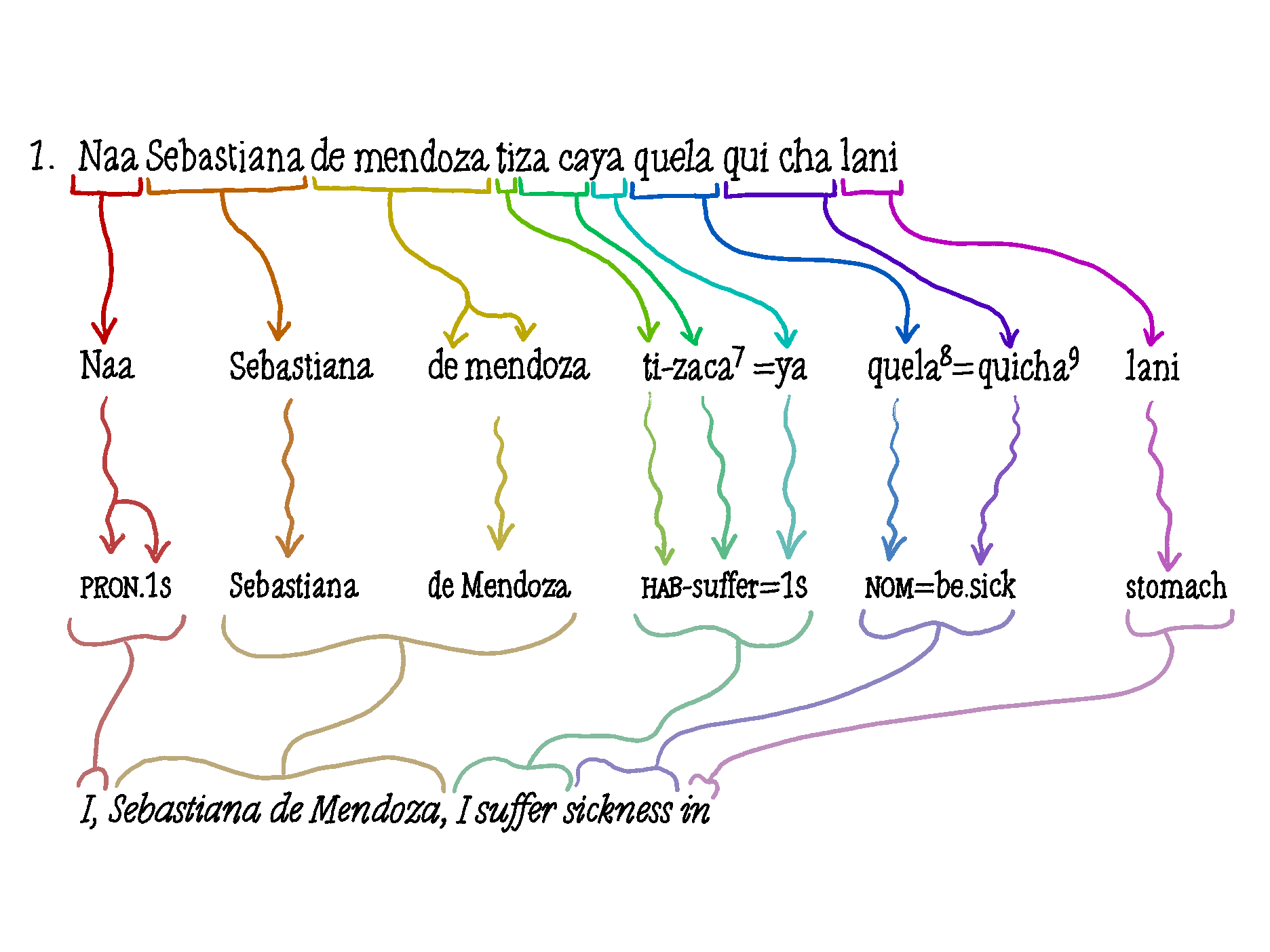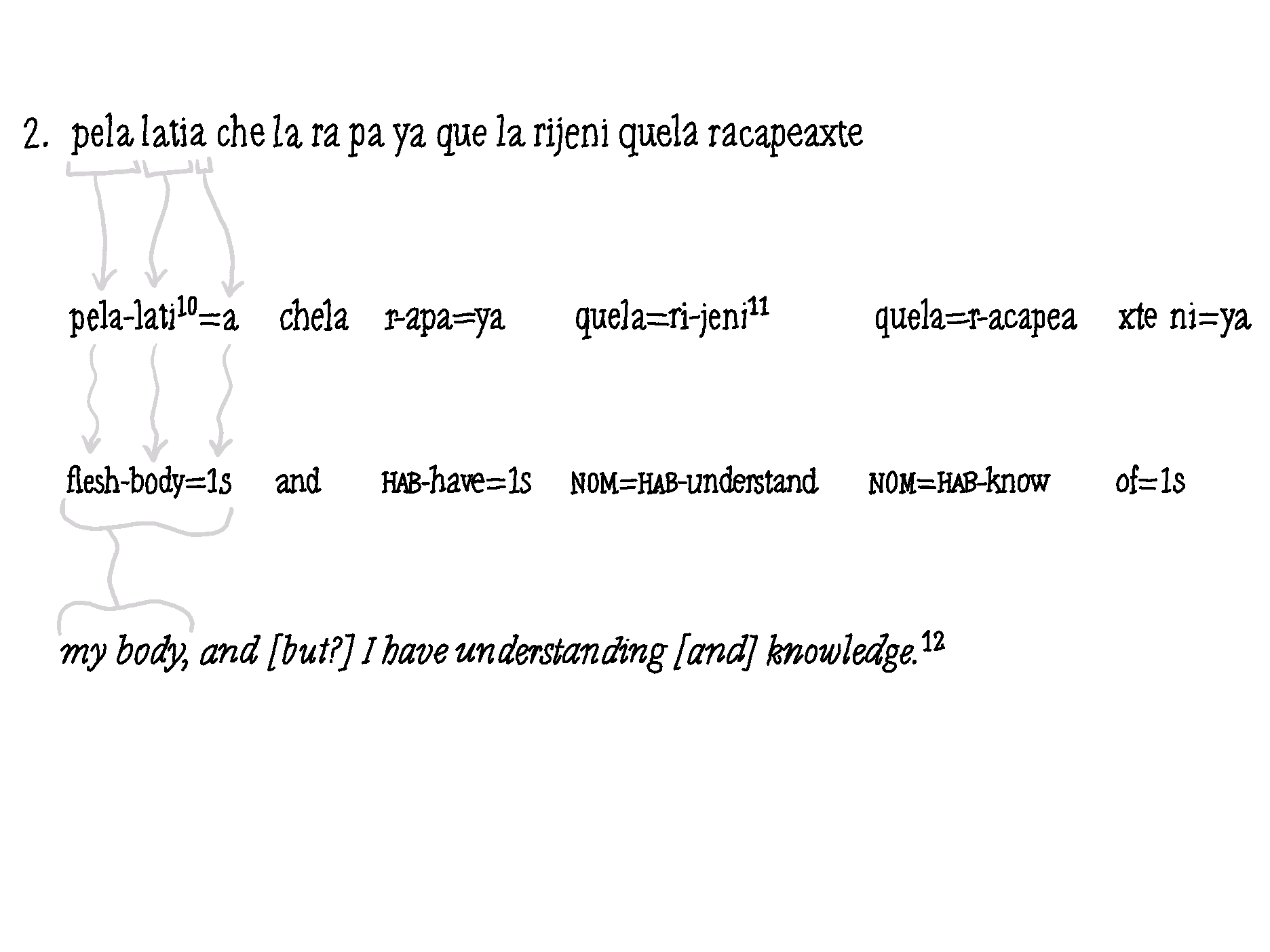Answer Key: Reading an Interlinear Analysis
Exercise 2.1
Part I: Look at the translation of the Colonial Valley Zapotec text given in the fourth line. Given the glosses, what are some other ways you could translate the words?
Part II: What sounds most natural to you? What do you notice about these different translations?
Part I
Answers may vary. Students’ translations should have a similar meaning as the translation given in line 4. For example, instead of saying I, Sebastiana de Mendoza, suffer sickness, one could also translate that portion as I, Sebastiana de Mendoza, am sick.
Similarly, the phrasing I have understanding from the translation of line 2 could also be translated as I understand.
Part II
Answers may vary. Students could note the use of “I” twice in the original translation, discuss the role of translation more broadly (i.e, when is it useful, what its limitations are), etc. Phrases in Zapotec, for example, may not be able to be translated with the same meaning into English, and vice-versa.
Exercise 3.1
Try to guess what the other two abbreviations (PRON.1S under naa, HAB under ti-, and 1S under =ya) might mean before reading the rest of this explanation.
The chapter gives the definitions of these abbreviations directly below the exercise. HAB stands for “habitual”, which describes an action that occurs/occurred regularly or customarily. The ‘1s’ stands for ‘first person singular’ — used when referring to oneself (I, me mine…)
Exercise 3.2
Below is an interlinear analysis of the next set of words from the Sebastiana de Mendoza text:

Explore the abbreviations you see in the third line of the analysis by answering the following questions: What do each of the labels tell you about the particular morpheme they are referring to? How does this meaning fit into the larger word and how it could be interpreted/translated? Consult the table of abbreviations as needed.
Answers will vary. Students may look up each label in the table of abbreviations, discuss usages of similar morphemes in their language, discuss how the table of abbreviations is categorized given what the abbreviations mean, etc. The abbreviations that occur in this line in particular are defined as follows:
| Abbreviation | Meaning | Example |
| 1s | “first person singular” | (I, me, mine…) |
| NOM | “nominalizer” (turns a word into a noun) | The -ness in happiness |
| HAB | “habitual” (an action that repeats or recurs) | I knit; I run |
Students may also find it helpful to consult the footnotes in this line, specifically footnote 11 — addressing different interpretations of ‘understanding’ versus ‘consciousness’. They may also discuss how the presence of a particular morpheme affects word choice in translation.
Exercise 4.1 How does it work in your language?
Select three lines from the interlinear analysis of the Sebastiana de Mendoza text. Look closely at the transcription and interlinear analysis. Do you recognize any words?
Answers will vary. Below is a table of words that Dr. Felipe Lopez, a native speaker of Dizhsa (San Lucas Quiaviní Zapotec), recognized from lines 2, 3, 5, 6, 7, and 8 of the analysis. Are any of these words familiar to you?
| Colonial Valley Zapotec | Line Number | Dizhsa | English Translation |
| pela latia | 2 | bel ladya | my flesh/my body |
| rapa | 2 | rap | have |
| racapea | 2 | racbe | know |
| xteniya | 2 | xtena | mine |
| sica | 3 | zica | only (emphasized) |
| Dios | 3 | Dios | God |
| gualica | 3 | wldiegza | truly |
| naca | 3 | nac | is |
| Tovisi Dios | 5 | teibyizy Dyoz | only one God |
| chij | 6 | tsë | ten |
| cayo | 7 | gai | five |
| cache | 7 | gaz | seven |
| chela | 8 | chiru | and |
| bexuana | 8 | bzhuan | lord |
Exercise 4.2
Using the illustration of line 1 as a model, draw arrows that connect morphemes, the glosses of those morphemes, and corresponding English translations for line 2. The first few morphemes are done for you.



Since chela is a conjunction that can be translated as ‘and’ or ‘but’, ‘[but?] ‘ is written with a question mark in brackets on the fourth line.
The second ‘[and]’ in the fourth line is also in brackets, here because it doesn’t directly correspond to a Colonial Zapotec word in the first line. In Colonial Zapotec, one way to express conjunction (‘and’) is to simply put the two words next to each other. But that doesn’t work in English, so we need to add an extra word to the translation.
Notice also that the xte at the end of the first line is written as ‘xte-ni=ya’ on the second line. Where did the ‘-ni=ya’ come from? Since this is an analysis of a written text, oftentimes scribes ran out of room on the paper before they finished writing a word, and thus used the next free line of the paper to finish writing the word. So the ‘xte-‘ is the beginning of the word ‘xte-ni=ya’, and the rest of the word ‘-ni=ya’ is written on the next line of the document (line 3 of the interlinear analyses).
Exercise 4.3
Answers will vary.
One idea is to consider the visual aspect of the analysis. How would the analysis be different if the lines were positioned in, say, a tree-like structure or a map with pointers (similar to the visual given in figure 3)?
Exercise 4.4
Try taking a sentence or phrase from your language and glossing it into English (or Spanish, or another language you know). What do you notice? What kinds of decisions did you have to make?
Answers will vary. Students may reflect on why they decided to equate two particular words in the two languages they chose.
For example:
- Juego futbol todos los días
Jueg-o futbol todos los día-s
play-1sg.pres.ind football every.masc.pl def.art.masc.pl day-pl -
She walks.
She walk-s.
3sg.fem caminar-3sg.pres
Here’s a table of the abbreviations used in these 2 examples:
| 1sg | first person singular |
| pres | present |
| ind | indicative |
| masc | masculine |
| pl | plural |
| def | definite |
| art | article |
| 3sg | third person singular |
| fem | feminine |
The glosses given above contain a lot of information! Single words can contain multiple morphemes, each of which lend a unique meaning to the word’s overall meaning. For example, the word ‘todos’, in addition to meaning ‘every’ in English, tells us that the thing following it will be both masculine and plural. The word ‘los’, which would be translated simply as ‘the’ in English, also encodes information about gender and number of ‘días’. Finding the right way to gloss a word is important, since you can get a lot of information from a word in one language that you can’t get in the language you’re translating it into (or vice-versa)!
Exercise 4.5 How does it work in your language?
Try translating one of the lines from the Sebastiana de Mendoza text into your language. In what ways is your Zapotec language similar to the Zapotec in Sebastiana de Mendoza’s will? In what ways is it different?
Answers will vary. Below is a translation of line 4 into Dizhsa by Dr. Lopez:
Line 4 (Colonial Valley Zapotec): Dios vixoce Dios xinij Dios espiritu santo chona persona
Dizhsa Translation: Dyoz bxuaz Dyoz zhiny Dyoz espiritu san chon person
Here are some (but certainly not all) similarities and differences students may notice between the Dizhsa and Colonial Valley Zapotec:
- There are fewer vowels at the end of the Dizhsa words than the Colonial Valley Zapotec words
- The Dizhsa and Colonial Valley Zapotec words are overall very similar
- The words in Dizhsa are in about the same order as the Colonial Valley Zapotec words